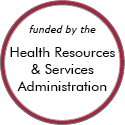Rural Project Examples: Infectious diseases
Evidence-Based Examples
Chronic Disease Self-Management Program
Updated/reviewed November 2025
- Need: To help people with chronic conditions learn how to manage their health.
- Intervention: A small-group 6-week workshop for individuals with chronic conditions to learn skills and strategies to manage their health.
- Results: Participants have better health and quality of life, including reduction in pain, fatigue, and depression.
Project ECHO® – Extension for Community Healthcare Outcomes
Updated/reviewed February 2024
- Need: Increase medical management knowledge for New Mexico primary care providers in order to provide care for the thousands of rural patients with hepatitis C, a chronic, complex condition that has high personal and public health costs when left untreated.
- Intervention: Project leveraging an audiovisual platform to accomplish "moving knowledge, not patients" that used a "knowledge network learning loop" of disease-specific consultants and rural healthcare teams learning from each other and learning by providing direct patient care.
- Results: In 18 months, the urban specialist appointment wait list decreased from 8 months to 2 weeks due to Hepatitis C patients receiving care from the project's participating primary care providers. Improved disease outcomes were demonstrated along with cost savings, including those associated with travel. The project model, now known as Project ECHO® – Extension for Community Healthcare Outcomes — has evolved into a telementoring model used world-wide.
Promising Examples
TelePrEP
Updated/reviewed May 2025
- Need: To prevent new cases of HIV in rural Iowa.
- Intervention: TelePrEP provides preventive care via telehealth and prescription delivery.
- Results: Between February 2017 and August 2020, TelePrEP received 456 referrals, with 403 patients completing an initial visit.
Other Project Examples
It's a Girl Thing: Making Proud Choices
Updated/reviewed June 2025
- Need: Teen pregnancy, sexually transmitted diseases, and mental health challenges in adolescent girls were concerns for members of Union Parish, Louisiana.
- Intervention: Union General Hospital, a Critical Access Hospital, created the program It's a Girl Thing: Making Proud Choices to teach prevention, self-confidence, personal responsibility, and mental well-being to teen girls.
- Results: Teen pregnancy rates in Union Parish have dropped by more than 40% since the start of the program, significantly exceeding the program's initial goal of 5%. Graduation rates have also increased. The addition of Together We Can Be Bully Free as an integral part of It's a Girl Thing has further expanded mental health support for participants.
Positively Living & Choice Health Network
Updated/reviewed May 2025
- Need: To provide affirming, destigmatized healthcare and support to thousands of Tennesseans living with HIV/AIDS, mental illness, substance use disorder, and homelessness – and prevention services for individuals at risk of contracting HIV.
- Intervention: Positively Living & Choice Health Network provides services including a medical clinic, pharmacy, therapy, case management, client services like housing aid and transportation, HIV prevention, and a harm reduction program.
- Results: The program currently serves 5,000 individuals and families through its offices in Knoxville, Chattanooga, Memphis, and Cookeville and its mobile medical unit for rural communities in Cocke and Claiborne counties.
Pacific AIDS Education and Training Center-Nevada

Updated/reviewed April 2025
- Need: To improve and increase prevention and care services for HIV, STDs, hepatitis C, and other infectious diseases.
- Intervention: PAETC-NV provides clinical and didactic trainings, conferences, technical assistance, capacity building, webinars, and other services to providers and healthcare organizations statewide.
- Results: In 2024, PAETC-NV trained more than 1,800 healthcare providers across Nevada to increase clinical capacity in the care, screening, and prevention of HIV, other sexually transmitted diseases, and hepatitis C.
The Possibility Shop
Updated/reviewed March 2025
- Need: To connect people in need in Allegany County, Maryland, to health and human services and to items like hygiene products, food, and clothing.
- Intervention: The Possibility Shop partners with health organizations, insurance navigators, food banks, and other agencies.
- Results: In 2024, 15,246 service encounters occurred and 940 intakes to services were performed.
High Rockies Harm Reduction
Updated/reviewed October 2024
- Need: To reduce drug overdose deaths and the spread of infectious diseases in rural Colorado.
- Intervention: This program provides harm reduction and peer support to people who use drugs and to their loved ones.
- Results: This program provided Narcan training to 377 individuals and distributed 2,448 doses of naloxone and 3,539 fentanyl test strips in 2023.
HIV Telehealth Collaborative Care (HIV TCC) Program
Updated/reviewed October 2024
- Need: To increase access to specialty care for rural veterans living with HIV.
- Intervention: The HIV Telehealth Collaborative Care (TCC) study connects these patients with HIV specialists via clinical video telehealth or VA video connect and works to create shared care relationships with primary care teams in rural areas.
- Results: The HIV TCC program provides HIV specialty care access to rural veterans in a sustainable manner with infrastructure, mentorship, and capacity building.
For examples from other sources, see:
